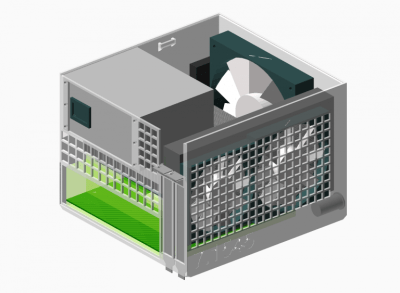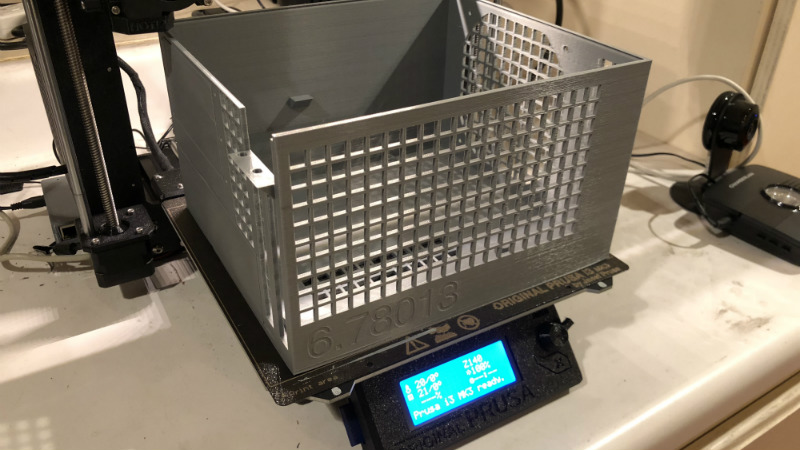We’re no strangers to 3D printed enclosures here at Hackaday. From the plethora of printed Raspberry Pi cases out there to custom enclosures for electronic projects, small plastic boxes turn out to be an excellent application for desktop 3D printing. But as printers get bigger and filament gets cheaper, those little boxes don’t always need to be so little. We aren’t talking about running off boxes for your sneaker collection either, if you’ve got the time and the print volume, you could whip up an enclosure for your PC.
 [Nirav Patel] writes in to share his impressive 3D printed Mini-ITX computer case project, which would be a neat enough trick in its own right, but he took the concept one step farther and made it a parametric design in OpenSCAD. This allows the user to input their particular hardware configuration and receive STL files for a bespoke case. The list of supported hardware isn’t that long yet, but with the OpenSCAD code up on GitHub and released under the BSD license, hopefully the community can improve on that as time goes on.
[Nirav Patel] writes in to share his impressive 3D printed Mini-ITX computer case project, which would be a neat enough trick in its own right, but he took the concept one step farther and made it a parametric design in OpenSCAD. This allows the user to input their particular hardware configuration and receive STL files for a bespoke case. The list of supported hardware isn’t that long yet, but with the OpenSCAD code up on GitHub and released under the BSD license, hopefully the community can improve on that as time goes on.
To keep things simple (and strong), [Nirav] implemented what he refers to as a “bucket” design. The majority of the case is a single print, which does take a long time (just shy of 40 hours on his Prusa i3 MK3), but nearly eliminates any post-printing assembly. Only the optional feet and the lid need to be printed separately. Threaded inserts are used throughout the design for mounting hardware, so you don’t run the risk of blowing out the printed holes during hardware changes or upgrades.
A particularly neat feature, and a testament to the power of OpenSCAD, is the fact that the case’s internal volume is calculated and embossed into the side of the design. Does this have any practical purpose? Not exactly, but [Nirav] thought it would be appealing to the Mini-ITX case modding community which apparently measures their accomplishments in liters of volume.
We’ve seen a 3D printed computer case before, but it used acrylic sheets and couldn’t be made without a large format printer. There’s something to be said for a project that can be completed on the hacker community’s favorite printer.
















Holy cow. I’ve used OpenSCAD for quick things and objects that lend themselves nicely to parameterization (eg. mounting brackets, etc). But THIS is dedication :)
Impressive!
The mother of all evil radiated emissions (aka PC motherboard) in a plastic housing.
Great idea!
Would you like to elaborate?
PC’s have a lot of high speed data buses running as long trace wires on the motherboard and cards. They radiate like antennas, producing a lot of RF noise. A good metal PC case is designed to ground and shield these emissions, a plastic one wont.
I doubt that many PC cases, especially the low end ones have any effective shielding. For instance, take a slimline HP server case circa 2000. It was all metal with rows of fine spring steel contacts along every edge of any removable lid with and a matching silver strip on the case areas. If your PC case has plastic slots, plastic viewing areas etc, it won’t stop much of anything.
I suspect that these days the mobos are designed to actually contain most of their emissions within their multilayer design, shielded parts where needed, tons of closely spaced vias which make the tracks into low loss waveguides and so on.
I’ve worked in a large, air conditioned Marconi Faraday Cage repairing radio communications equipment and the design of a metal enclosure needed to really stop RF, is far from trivial.
Even lower end cases are shielded fairly well and they have to be, as the FCC would whip the manufacturers if they weren’t. It’s never just plastic slots, there’s a metal piece behind it too. When that’s removed to fit something like a CD player, the metal case of that part takes over the shielding duties. Even in very mundane systems a lot of care is taken to reduce and limit emissions. A lot of manufacturing cost could be eliminated by removing the shielding features.
Some manufacturers who only sell cases obviously don’t comply properly by selling cases with massive windows on the side, but that’s not because shielding is no longer relevant. Some may be mitigating issues by coating the windows with some form of metallic layer, but it’s more likely a lot don’t. Emission standards have become more and more stringent, rather than the opposite.
Most of the modern day buses (except memory) are differential signals. The amount of radiated noise is much reduced as the magnet field of the closely routed diff. signals tends to mostly cancel themselves out.
To get the high speed bus working, there are more signal integrity (SI) done on their design. Most of the good SI that deals with undershoot, overshoots, reflections (impedance matching/terminations) reduces excess energies and hence reduces emissions. Signals properly routed on solid power planes have reduced return paths – less loop area less effective radiators.
Most HaD project however are badly routed as few have the SI and EMC trainings if any, but that’s a different discussion. I worry more about the loose non-impedance controlled unterminated signals, bad decoupling, loose wires, breadboards, modules etc more than PC components designed by engineers.
Cyk, thank you for mentioning this. I thought I was going to have to! I wish HaD would think more about things like causing interference both with intentional and unintentional radiators and at least mention both the legal and moral questions regarding some of the projects they post. (imagine interfering with public safety communications) Just look at the bagphone article posted the other day!
I’m not even suggesting they censor these articles, only at least mention the issues. Hey.. btw… if you duplicate this project without a license that you almost certainly do not have you are breaking the law and if caught could be subject to 10s of thousands of dollars in fines. Or.. if you do this you might interfere with the radios used by your local ambulence service. For this article maybe nothing that extreme but how about.. “you might consider lining the inside of your 3d printed computer case with something conductive. Otherwise you could cause interference to your own devices or worse yet your neighbors. Be a good neighbor.”
Marcus, Tekkieneet, It’s good to know that computer parts are becoming less noisy. I still have a hard time believing that they are THAT much cleaner that shielding is no longer a benefit.
Terry, A few years ago I toured the design office of a very large corporation that was until recently the manufacturer of a large percentage of the two way radios and later cellphones used worldwide. They showed us one of their early Farady cages. It was a frame made of 2x4s with chicken wire stapled to it. I asked about it and the lady giving the tour said they even still use it sometimes!
I suspect that the difference may be in frequency. I doubt that cage could even take a bar off my cellphone had I walked in. I am pretty sure they used it for testing HF gear. It’s true that todays computers have very fast CPUs and busses. Most of the oscillators are running at UHF/SHFfrequencies that are hard to shield. Computers seem to emit crap all over the spectrum though. A shielded case, even with a plastic front will still do well for lower frequencies and those are the ones that carry farther thus matter more anyway.
Yeah. Interference from high frequency smooching is quite an annoying source of rf.
It’s spelled buses.
My 486 absolutely clobbered the 2-meter band any time the case was off while it was running. On the other hand, I’ve run multiple modern computers with no side on the case for years at a time without issue. No matter what band I’m looking at. I don’t think it’s that much of a problem these days.
i cant imagine it being too difficult to give it a coat of conductive paint and some foil tape in some areas. as good as a metal enclosure, probably not, but its something. conductive filament is also an option.
My wife’s current (temporary) desktop is running in the cardboard box that the motherboard came in, and the wifi, cell phones, GMRS radios, etc., in the same room all still work. ;)
I haven’t even noticed any spurious noise on my oscilloscope! YMMV, but it seems to be less emissions than are caused by standing up or sitting down. I think you have to be doing something really really sensitive in a very narrow frequency range and with a low amount of power to notice it.
Mine is in a metal case, but I keep the side panel removed for air flow. If you enclose it, it needs a case fan in addition to the CPU fan, and considering how the case fans are usually mounted I doubt it even reduces emissions. But the extra wasted power and increased noise would both annoy me more than irrelevant emissions. But I can see how if my hobby was listening to the fuzz near the edge of a radio’s reception, then it be a different evaluation.
I’m pretty sure this is a thing of the past because open air cases and test benches can be had from well known companies and you don’t see interference warnings about them from the manufacturer or on the internet.
Wouldn’t a plastic case build up static electricity?
I’ve personally printed 2 mini-itx “boxes”, one from a model from thingyverse, nice and pro and about half height of what is shown here and one super minimalistic which I designed myself, also in OpenSCAD. I used honeycomb mesh for the vents, it’s (imho) prettier and sturdier than square mesh, maybe easier to print too.
For me it’s used to store the two boards, not to actively run them. I wouldn’t bother too much about static, there isn’t any moving parts able to produce much static if you don’t use an removable media drive. If there is a fan that could be a concern, but my mini-itx boards are fanless.
My mini-itx lives in an old Panasonic RK-T45 electric typewriter.
This looks pretty much exactly like $40 Silverstone Sugo SG13 case, which is an amazing case.
i doubt il replace my elite 110 with this any time soon. but i do like it. my printer just doesnt have the build area for this. i had to print my pi tablet case in 2 parts because of this.